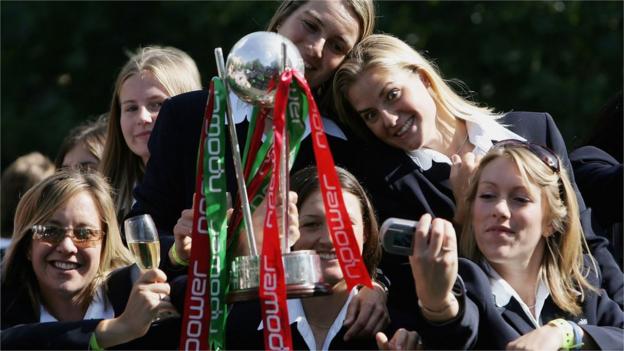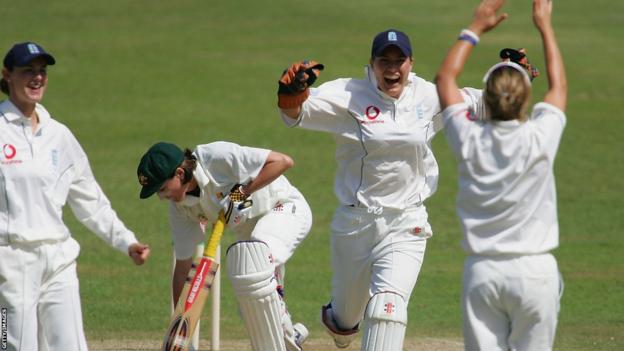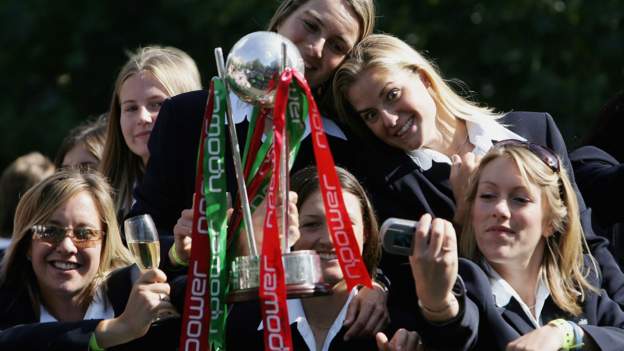
It is late summer, 2005. Eleven English cricketers are putting the finishing touches to a Test series victory over their oldest enemy, Australia.
It is a win that ditches decades-old historical baggage and heals deep psychological scars, and it will prove to be the starting point for an even bigger movement.
The journey towards becoming the number one-ranked Test team in the world begins with this narrowest of series wins, as just one Test victory separates the sides.
Andrew Flintoff, Kevin Pietersen and Steve Harmison taking down arguably Australia’s greatest side featuring Shane Warne, Glenn McGrath and Ricky Ponting?
Wrong.
A few weeks before England’s men sealed their first Ashes victory in 19 years – an iconic moment revisited in new BBC Sport documentary How to Win the Ashes – England’s women ended their own 42-year wait for a Test series victory against Australia.
Unlike the men, however, their victory was a footnote – both at the time and largely since.

The ‘Forgotten Ashes’ heroes of 2005 were not treated as rock stars like their male counterparts. They certainly weren’t handed MBEs en masse like the men’s team. In fact, skipper Clare Connor was the only member of the squad to receive royal recognition with a CBE.
They did receive an invite to the open-top bus celebratory tour of London. However, they were behind the men’s team in every way.
“We got to drive on a bus around London. Our bus was behind and everyone thought we were the Wags (wives and girlfriends),” pace bowler Katherine Sciver-Brunt remembers.
Aged just 20, Sciver-Brunt was the player of the series. She took 14 wickets across the two Tests and scored a vital 52 in the second-Test victory at Worcester which ultimately sealed a first Ashes series win since 1963.
“If I did what I did then in this summer’s Ashes, I’d have had a deal with Nike, a Kookaburra contract and one of the highest-paid IPL contracts,” she says.
“As it was, Slazenger gave me 50% off their kit. And all we got for winning really was a high five.
“There is a bit of anger for a lot of us. A lot of people were ignorant and it wasn’t celebrated in the way it should have been.”
Some of that ignorance was, unavoidably, within Sciver-Brunt’s own family.
“I had a Nokia 5210 and would be ringing my dad to tell him the score with whatever credit I had at that time,” she says.
“Or I would send an email to his work to let him know. There was no other coverage or way for him to know what was happening.”
Those texts would have made for tough reading at the start of the summer.
Australia were long established as the best in the world.
They were the World Cup holders and, just as in the men’s game, the years of Australian dominance had scarred some of the more established members of the England side.
As Clare Connor admits, 1995 to 2005 was “an incredibly tough decade for England against Australia”.
Australia’s supremacy seemed set to continue during the first half of the first Test at Hove. In the first innings, despite being reduced to 191-8, Australia scored 355, thanks largely to 81 not out from Shelley Nitschke.
“Cathryn Fitzpatrick was the best in the world at that time and the fastest bowler ever,” Sciver-Brunt says. “She was relentless – and evil.
“They had two world-class spinners and so much depth in their batting. Nitschke came in at number 10 in the first Test and she opened the batting for her state.”
England looked to be staring down the barrel of defeat at 14-3 in the second innings, but a backs-to-the-wall hundred from 23-year-old Arran Brindle secured a draw and hinted at a burgeoning belief, especially among the younger players.
“For so long Australia had dominated, but we had got a glimpse of getting close to Australia three months before that at the 2005 World Cup semi-final in South Africa (Australia won by five wickets), where we felt we could overturn them,” seamer Isa Guha says.
“That belief was starting to ferment.”
Sciver-Brunt didn’t fear Australia – or anything, for that matter.
“I didn’t have any fear at all. I had been in the side for a year and had found my feet,” she says.
“I didn’t have the scars everyone else had about playing against Australia.
“I also had a personal superpower – I had none of the mental nonsense and worries that I had in the rest of my career back then. It was the one and only time I didn’t feel burdened.”
The burden of history was a heavy one, but the tide was turning.

Between the first and second Tests, England claimed their first one-day win over Australia in 12 years. It came after 19 straight defeats, a losing run which stretched back to the 1993 World Cup. It was also the first time Connor had beaten England’s arch rivals.
“It was a miracle occurrence – we were acting like we’d won the World Cup,” Sciver-Brunt says.
Less than a week later England did it again – in the second and final Test of the series.
Victory came in no small part thanks to Sciver-Brunt, who took nine wickets and shared a crucial 10th-wicket stand of 85 with Guha.
England had won the Women’s Ashes for the first time in 42 years. It was the first time Australia had lost a Test in 21 years.

“I’ve never seen a team explode with so much relief and shared joy when we won there,” Connor said in 2015.
“We jumped up and down like children on the dressing room balcony and then charged on to the pitch together. Without doubt, it was one of the best days of my life.”
The press coverage certainly didn’t match the team’s celebrations.
Sciver-Brunt remembers being beside herself to see just her match figures of 9-111 scroll across the bottom of the screen of a BBC News report.
Physical mementoes of their glorious summer are pretty much non-existent.
“The memories are in my head only,” she says. “I have about three photos to my name of that summer, and I’m only in one of them. It’s really sad.”
One indelible memory was the Trafalgar Square celebrations, where thousands of people turned out in London to celebrate England’s Ashes success.
How Sciver-Brunt and Guha frame those images, though, is difficult.
“We saw the men’s team the way the public saw them, as our heroes,” Scriver-Brunt says. “So getting to have a drink with them at times – it was wild, we thought we were rock stars.
“It was like being backstage for us at a massive gig like Coldplay or Justin Bieber, or Foo Fighters for me.
“But at the same time, again both then and reflecting on it now, there was a more complicated, nuanced feeling – a feeling of being patronised that didn’t sit well in 2005 or nearly 20 years later.”
Guha says: “We’d had a perception of us for such a long time that we were second to the men’s team.
“There was a genuine feeling of gratefulness to be there. On my journey in the game that’s obviously changed as we’ve tried to strive for equity in cricket and sport.”
Sciver-Brunt is more blunt. “2023 is drastically different,” she says. “Every Ashes game will end up being sold out this summer and they are playing at grounds like the The Oval, Edgbaston and Lord’s.
“We were at places like Worcester, which we were really pleased about at the time because it was a step up from Scarborough.
“We had to wear our really naff suits at the celebration – they were feral.
“And then even on the pitch when we played we wore the men’s Test kits – we drowned in them.
“We always shared rooms. If someone made you share a room now you’d kick off.”

England’s victory kicked off a transformative journey for the women’s game, on and off the field.
Four years after their 2005 Ashes triumph they topped the world rankings after an incredible 2009 which saw them retain the Ashes, win the World Cup in Australia and the World Twenty20.
England’s series win might have played second fiddle in 2005, but the series has a lot to be credited for in the growth of the women’s game.
Earlier this year Sciver-Brunt saw her wife and England team-mate Nat Sciver-Brunt became one of Britain’s highest-paid sportswomen when she was auctioned for £320,000 in the inaugural Women’s Premier League.
Inevitably, such a growth in potential earning power, coming in just as Sciver-Brunt herself is preparing for international retirement in May, has its frustrations.
Ultimately, the ‘Forgotten Ashes’ will never be any such thing for Brunt and her team-mates.
“Sometimes I wonder what it would be like if I had started my career now,” she says. “But you can’t really dwell on that.
“The 2005 Ashes was one of my top three cricketing memories across my entire career and one I never really managed to replicate.
“When has it ever been 42 years since you were able to beat someone? The odds were really against us. The longer wait made it even better.”





















